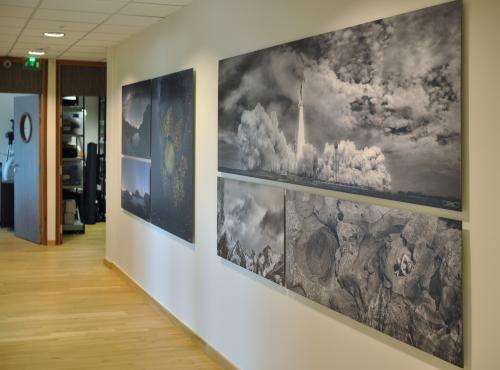Final flight, first sight

Bert Pasquale's father took him to see a shuttle launch when Bert was a teenager. Now an optical engineer at NASA's Goddard Space Flight Center in Greenbelt, Md., and internationally recognized photographer, Pasquale took his then 5-year-old son to see the last shuttle launch hoping to instill in him the same connection with space he had felt as a youth.
He also wanted to professionally photograph the launch. He managed to do both. As a bonus, his panoramic image, "Final Flight," won the Grand Imaging Award (Illustrative, third place) in the Professional Photographers Association's 2012 International Photo Competition.
Pasquale had to wrestle with a few logistical and technical issues involved in photographing a launch. He first had to obtain press accreditation through the Kennedy Space Center News Center, but his credentials did not extend to his son or wife so they could not be anywhere near the site.
He set up his equipment in the area around the launch pad the day before the launch. Arriving onsite with the necessary gear, his equipment was examined by guards with bomb-sniffing dogs before he boarded a press bus to the designated area. Even the press and VIPs cannot view a launch any closer than three miles away, so all launch pad-area cameras must be triggered remotely. Given the volatile nature of launch windows, no one is ever certain when liftoff will occur.
Pasquale specializes in large panoramic views, often composed of many images. "I approached documenting the final space shuttle in the same way that I would any artistic piece, applying elements of composition and lighting to tell the story," he said. To capture his vision of the launch, he set up two professional digital SLR cameras, one with a wide angle and one with a telephoto lens.
"I was learning on the fly," said Pasquale. "My cameras were connected to a device especially developed for launch photography: a sound trigger programmable to activate only during a specified range of launch windows." He secured the cameras in a birdhouse-like structure he built to protect the gear from the elements, which was fortunate as thunderstorms plagued the area for part of the time before launch.
The day of Atlantis' final launch, Pasquale chose to view the launch from the Port Canaveral causeway with his wife and young son, 14 miles away, rather than alone at the premium location reserved for the press. As Atlantis rose into the sky, and now equipped only with his iPhone and camcorder, he turned his video camera to his son's wide-eyed face. "I asked him what he saw, and he said, 'A big fireball!' We still talk about it. Being there together will always be a connection point for both our family and my son's love for space," he said.
It wasn't until retrieving his cameras several hours after the launch that he learned that the remote triggers had worked. "I was ecstatic– everything worked perfectly!" Pasquale said. "It was a payoff for months of planning."
Pasquale processed multiple images from both of his professional cameras and added images of the sky from his iPhone to compose an ultra-high resolution panoramic image. He toned the image in black and white to accentuate the emotion and drama of the shuttle's final launch.
"Imaging to me is always about conveying a message or emotion. This image is an iconic representation of NASA's mission, but also personally connects my own work at NASA to its ultimate use in space. I was glad to be a part of helping the world remember this era, but as both an engineer and a photographer, I was very sad that there will be no more shuttle launches," said Pasquale.
The largest print yet made of "Final Flight" is eight feet wide. It hangs with two of his other panoramic images in the lobby of a French company, set against the backdrop of the foothills of the French Alps.
Pasquale's next lofty goal is a documentary photo shoot of NASA experiments aboard the "Zero-G" Boeing 727. "I'm looking for a zero-gravity flight experiment that I can join. I'd love to create unique images to support their project," he said.
PPA announced the Grand Imaging Award in February. "I loved that NASA was getting recognition too. I think the image won because the judges connected with the moment, with NASA and with what we do. That's the image's true success," he said.
Provided by NASA




















